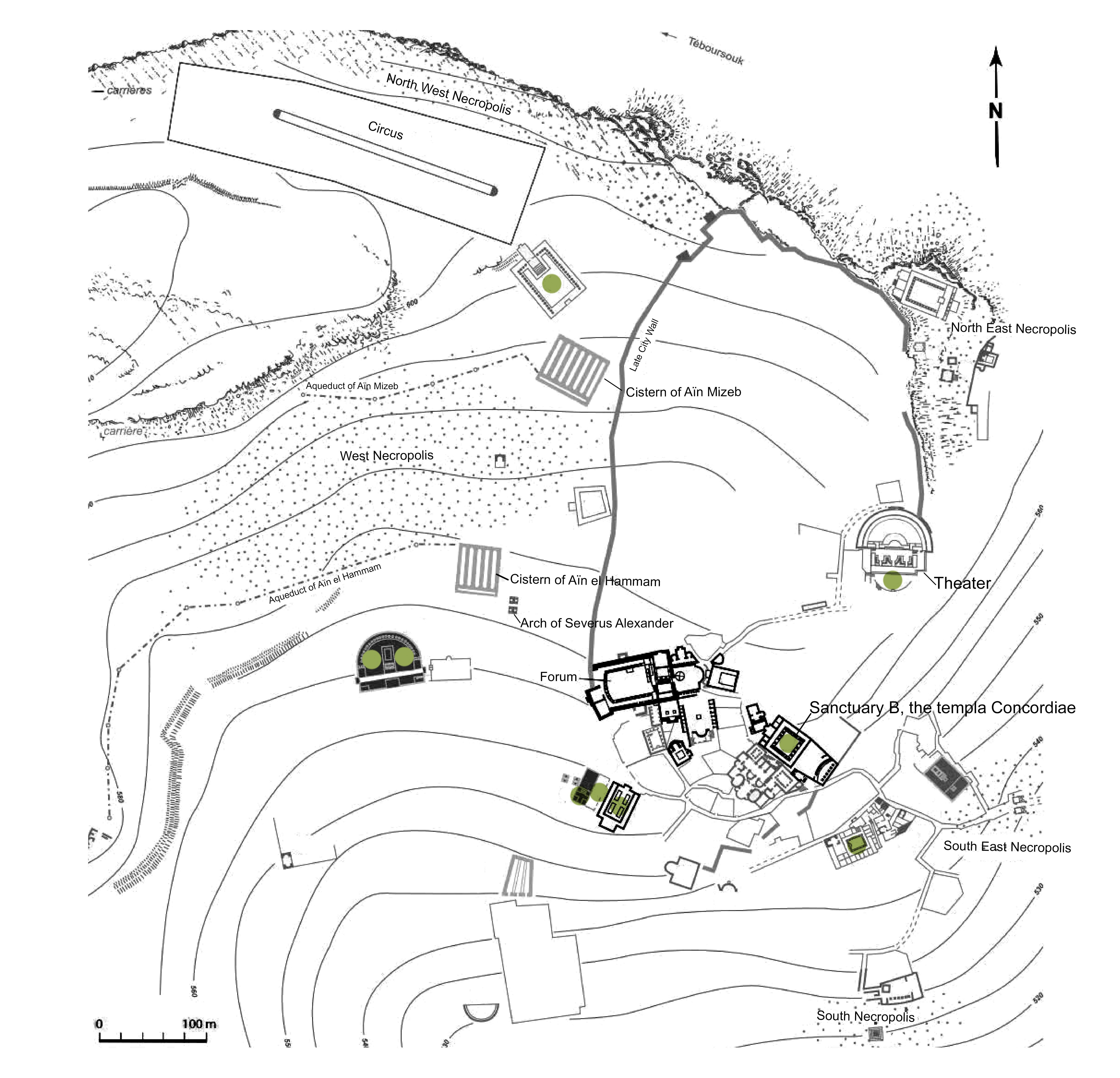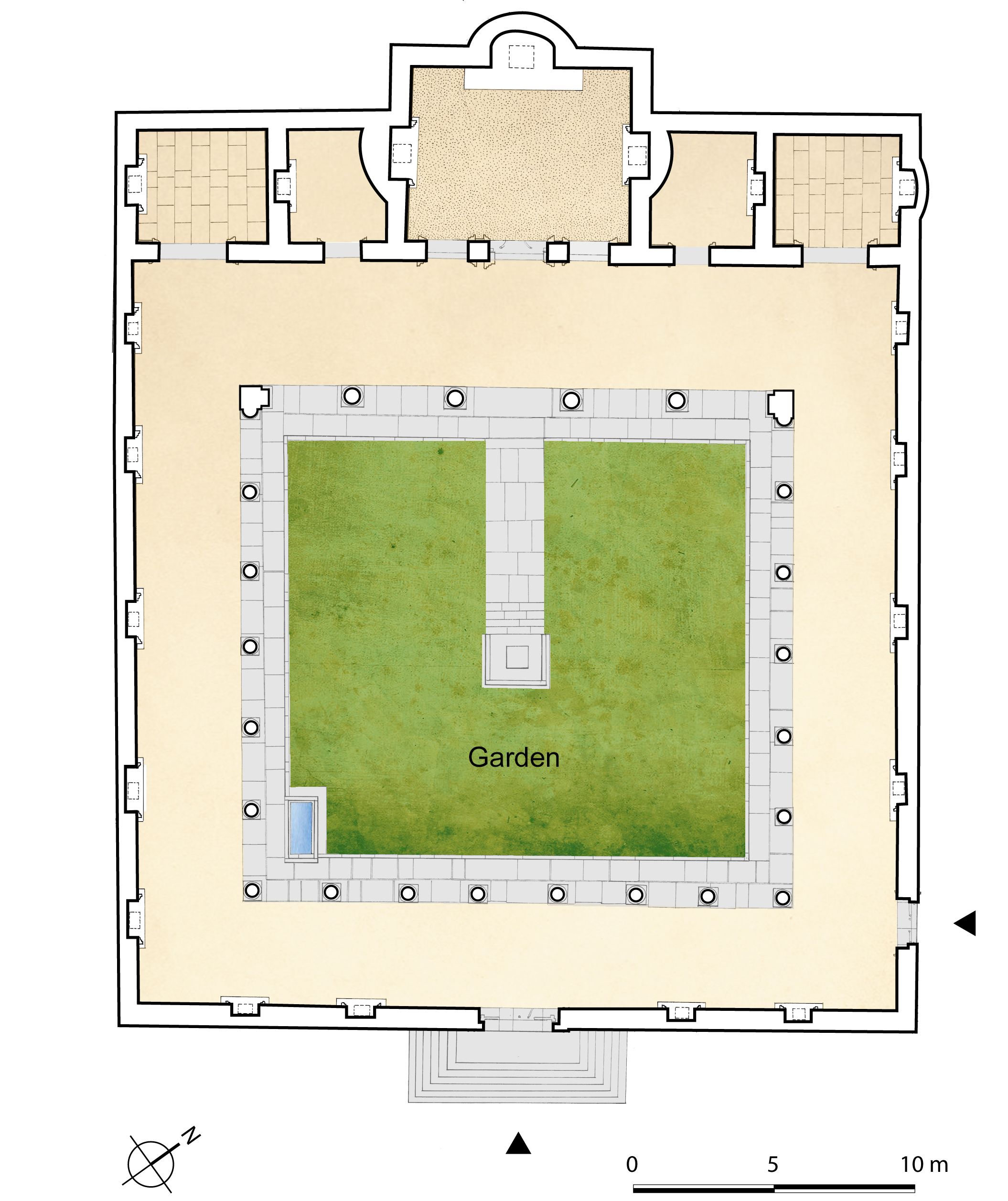Sanctuary B, the templa Concordiae
Province
Africa Proconsularis
Africa proconsularis (Pleiades)
Province Description
The history of Roman Africa begins in 146 BC with the destruction of Carthage and the establishment of the province of Africa in the most fertile part of the Carthaginian Empire. The new province covered about 5000 square miles (17,172 square kilometers) of the northern part of modern Tunisia. A praetor governed the area from his headquarters at Utica. The Romans inherited a thriving agriculture developed by the Carthaginians. The climate was hospitable. Wheat and barley were the most important cereals; wine and olive oil were also produced and there were various fruit trees.
Location
THUGGA (Dougga) Tunisia
THUGGA (Dougga) Tunisia (Pleiades)

Plan of Thugga (Maurin, L., d’après le relevé général de Cl. Poinssot, Les ruines de Dougga, 1959, pl. h. t.)
Location Description
Annexed in 46 B.C., the Romanization of the city of Thugga that was probably a residence of the Numidian kings, was gradual but profound. It became Municipium Thuggense in 205, and was raised to the rank of a Colonia Licinia Septima Aurelia Alexandriana Thuggensesin in 261 under Gallien. Numerous buildings of this city overlooking the valley of the Ouadi Khaled, have been uncovered among them the Capitol dedicated to the Capitoline Triad in 166-67, the theater on the top of the plateau constructed under Antonius Pius, the Temple of Mercury, Fortune, Augustan Piety, Liber Pater, Concordia, Frugifer, Pluto, Saturn and the Temple of Caelestis which stands in the middle of a an olive grove. In the residential areas stands the Licinian Baths with their Palestrae and the Cyclops Baths and the Triumphal Arch of Septimus Severus set astride a street leading down the hill. Two building inscriptions (CIL VIII, 26606 and CIL VIII, 26607), dated to AD 166-169 mention a theater with a basilica, porticoes, and xystis.
Garden
Sanctuary B, the templa Concordiae
Keywords
Garden Description
Sanctuary B, the templa Concordiae (117-138 CE), is a monument from the time of Hadrian dedicated to several deities, four of whom are known from the texts: Concordia, Frugifer, Liber Pater and Neptune. The complex is distinguished from the other cult complexes of the city by the integration of a sacred theater. The sanctuary comprises a courtyard surrounded by a quadriportico on which five cellae opened to the northwest. The largest and most elaborate, that dedicated to Concord, is located on the axis of the building and its extension in the theater below. This axiality is expressed by a central aisle that leads from the western portico to the altar located in the center of the courtyard. The area was not paved; one can imagine that it was planted as a garden whose vegetation formed a green setting around the altar.
Maps
Plans

Fig. 1: Plan of the Sanctuary B, the templa Concordiae (From Aounallah, S., Golvin, J.-C. (dir.) 2016, p. 505, fig. 44)
Dates
117-138 CE
Bibliography
- Aounallah, S., Maurin, L., "Remarques sur la topographie rurale et urbaine du pagus et de la ciuitas de Thugga (Dougga, Tunisie)", in Hommes, cultures et paysages de l'Antiquité à la période moderne : Mélanges offerts à Jean Peyras, Rennes, Presses universitaires de Rennes, 2013. (worldcat)
- Aounallah, S., Golvin, J.-C. (Dir.), Ben Rhomdane, H., Brouquier-Reddé, V., Chehidi, M.A., Ghaki, M., Khanoussi, M., Maurin, L., Saint-Amans, S., Dougga, Études d'architecture religieuse 2. Les sanctuaires du forum, du centre de l'agglomération et de la Grande rue courbe (Mémoires, 42), Bordeaux : Ausonius Éditions, 2016, p. 440, fig. 86. (worldcat)
- Malek, A.-A., "Le jardin dans les sanctuaires du Maghreb romain, premières approches", in Du culte aux sanctuaires : l’architecture religieuse dans l’Afrique romaine et byzantine, Brouquier Reddé, V., Baratte, Fr., Rocca E. (dir.), Paris, de Boccard, coll. Orient et Méditerranée, 2018, pp. 213-230, p. 360, pl. 10. (worldcat)
Pleiades_ID
TGN ID
Contributor
Amina-Aïcha Malek (ORCID: 0000-0002-1628-615X)
Publication Date
21 Apr 2021